First Indian circumnavigation
The first circumnavigation by an Indian crew was undertaken in 1985-1987[1] by the Indian Army Corps of Engineers on yacht Trishna, a 1970-vintage Swan 37 sloop.
Trishna was given the singular honour thereafter of being transported to New Delhi and displayed on a tableau during the Republic Day Parade, 1987.[2]
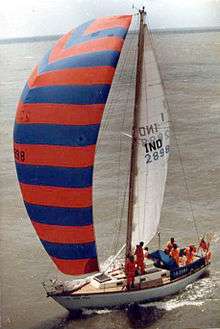
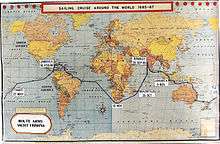
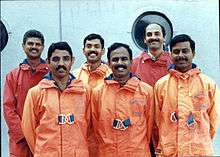
Prelude
On 28 September 1985 Trishna set sail from the Naval Sailing Club jetty at Colaba, Mumbai with General Arun Shridhar Vaidya, then-Chief of the Army Staff (India) accompanied by Lt. Gen. P.R. Puri, Engineer-in-Chief flagging off the First Indian Expedition Around the World.[3]
Team
The team consisted of ten members, with six on the boat at any one time, of which four were permanent crew:[3]
- Maj K. S. Rao, SC, SM, - Skipper
- Maj A. K. Singh, KC, SM
- Capt Sanjeev Shekhar, SC
- Capt Chandrahas Bharti, SC
- Maj Amreshwar Pratap Singh, SM(Bar), VSM - sailed from Mumbai to Panama;
- Capt Rakesh Bassi, SM - sailed from Mumbai to Trinidad;
- Lt Navin Ahuja, SM sailed from Trinidad to Auckland;
- Col T. P. S. Chowdhury, AVSM, Team Manager, sailed from Panama to Sydney;
- Maj A. Bhattacharya, SM, sailed from Auckland back to Mumbai; and
- Maj S. N. Mathur, SM, sailed from Sydney back to Mumbai.
Circumnavigation
Bombay to Trinidad
The sailing expedition commenced from Bombay, India on 28 Sept 1985.[4] Right from the time Trishna left harbour, she ran into the low pressure weather system of the receding monsoons which accompanied her till her first port of call at Male and thereafter to Mauritius on 25 October 1985.[5][6] The boat was hit by severe storms on several occasions which damaged the VHF and HF radio aerials and electrical systems on board. The crew resorted to makeshift repairs at sea to restore communication and navigation systems[7] After a brief halt, the boat set sail from Port Louis, Mauritius on 30 October 1985. The sail to Saint Helena, South Atlantic Ocean around the Cape of Good Hope was rough and the longest non-stop leg of the trip, taking 33 days. Trishna on one occasion was swamped by a rouge wave and lost most of her life saving equipment in the incident. The radio set was damaged and the antenna on the masthead broke. Communication with Mumbai and other ports was cut off. The sail across the South Atlantic Ocean was peaceful and Trishna reached St Helena on 2 December 1985.[8]
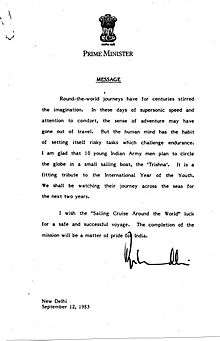
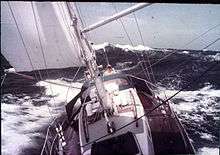
The boat reached Ascension Island on 15 December 1985.[9][10] Staying ashore or mooring on the island was not permitted there and Trishna had to tie up alongside the oil tanker Maersk Ascension which is permanently anchored off the island[11] The sail thereafter till the Caribbean Sea was largely calm. The winds remained predominantly South-Easterly. The first port of call on the continent of South America was at the coastal town of Natal.[12][13] The crew celebrated the New Year of 1986 there with their Brazilian Navy hosts. From there, the boat sailed along the coast and then up the Para River to the port of Belem. Trishna had to sail upstream on this tributary of the Amazon River for 70 nautical miles against strong currents.
The next halt was at the port of Paramaribo, Suriname. The country has a large East Indian origin population and programs in Hindi were broadcast by the local radio station. It was a short hop from there to Georgetown, Guyana. The crew received an enthusiastic reception from the large Indian-origin population here. The Guyana Defence Force arranged a visit to the Kaieteur Falls by air during the short stay there. Trishna then proceeded to the Caribbean port of Port of Spain, Trinidad and Tobago for the first crew change of the voyage. Capt R. Bassi was replaced by Lt. Navin Ahuja.[14][15]
Trinidad to Panama City
The boat then sailed to Bridgetown, Barbados[16] and then to Kingston, Jamaica. From there the boat crossed the Panama Canal.[17]
At Panama City, the boat was taken out of the water and overhauled at the local US Naval Base.[18][19] Minor repairs were carried out, barnacles removed and the hull was given a fresh coat of anti-fouling paint by the crew.
Panama City to Auckland
The voyage in the northern Pacific Ocean was relatively calm. With good winds Trishna sailed the 3,200 nautical miles – from Galapagos to Marquesas Islands non-stop in 23 days. This was her fastest passage so far.
Trishna halted at Tahiti[20][21] and then onward to Raratonga and Suva, Fiji. The weather remained adverse on the leg from Fiji to Auckland. Winter had already set in the Southern Hemisphere by this time and the sail was extremely punishing for the crew in the wet and cold conditions.
Trishna again had a perilous encounter with some whales between Raratonga and Fiji. On three occasions whales came within 10 to 15 meters of the yacht, dived underneath and swam nearby flipping their huge tails[22]
Auckland to Sydney
One of the most difficult legs of the voyage was the passage from Auckland to Sydney across the Tasman Sea. The leg was sailed from 03 to 17 Aug 1986. Trishna was hit by gales continuously for five days. The sails were ripped off and for the first time in the expedition, the ‘hove-to’ drill was carried out to ensure that the boat did not suffer major damages. The same storm meanwhile struck Sydney, causing the worst inundation of the city in the century.[23]
Sydney to Bombay
The leg Sydney - Brisbane - Cairns - Thursday Island continued in rough weather, as predicted during the winter months. The voyage was difficult, though spectacular, owing to the sail along the Great Barrier Reef. Navigation was critical while sailing through the numerous reefs and on one occasion the boat ran aground on a moving sandbar. Fortunately there was no damage though the crew had to wait till the next high tide to sail the boat off. The sail through Torres Straits again caused anxious moments as the Strait is only about a mile wide and it was a challenge navigating through this narrow passage. From Thursday Island to Darwin was a pleasant sail and the crew finally got some respite from adverse weather conditions. This gave the crew opportunity to work on the communication equipment to re-establish radio communications with India through the HAM network. Since rounding the Cape of Good Hope, there had been no direct communication between the boat and India. Maj SN Mathur was an expert HAM operator and he soon established a regular link with India.
Trishna left Darwin, North Australia on 13 October 1986 for Kupang, Timor. From there the boat sailed to Waingapu in Sumba and then to Bali, Indonesia. Good ‘following’ winds helped Trishna reach Bali on 22 October 1986. Bali has many Hindu temples and the crew arrived during one of the main Hindu festivals, Diwali, the festival of lights. This was the third Diwali celebrated by the crew away from home.
The yacht set sail from Bali on 2 November 1986, reaching Jakarta on 9 November; then via Singapore and Penang, Trishna made its first landfall on Indian shores at Campbell Bay, Nicobar on 10 December 1986.[24][25] It was a momentous occasion and was celebrated with gusto with the whole crew present on the occasion. Maj KS Rao, the Skipper, also received his long delayed promotion to the rank of Lieutenant Colonel here.
The home run via Colombo, Sri Lanka was uneventful.
Trishna received an enthusiastic welcome at the Gateway of India, Mumbai on her arrival there on 10 January 1987 where she was received by General Krishnaswamy Sundarji, the Chief of the Army Staff (India) accompanied by a large gathering of sailors, Service officers, friends and relatives.[26][27]
Admiral Ronald Lynsdale Pereira, Former Chief of the Naval Staff in a letter to a crew member, from Bangalore; dated 18 March 1986.
Achievement
Ten officers of the Indian Army Corps of Engineers in a sailboat girdled the globe – 30,000 nautical miles – in less than 16 months creating Indian maritime history.[28] They are the first Indians to circumnavigate the globe on Trishna - in Sanskrit the name means to fulfill their ‘thirst’ of sailing around the world.
Honours and awards
Trishna was given the singular honour of thereafter being transported to New Delhi and took part on a tableau during the Republic Day Parade, 1987.[2] This in itself was a herculean effort as the boat had reached Mumbai on 10 Jan 1987 itself and to participate in the Republic Day Parade on 26th, the boat had to be transported to New Delhi, the tableau to be fabricated to the exacting standards of the Ministry of Defence and cleared by their internal committee well before the rehearsals commenced. It seemed an impossible task, but with the concerted efforts of all those involved, the Indian Railways provided the carriage, Naval Dockyard Mumbai fabricated the boat cradle overnight on the railway carriage and then again the Railways moved it at express speed, literally, to New Delhi. The Bengal Engineer Group, Roorkee sent their fabrication team and completed the fabrication work at Vijay Chowk itself since the boat with its 54 ft high mast could not be transported anywhere else in the capital.
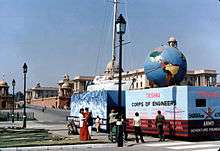
A commemorative postage stamp was released by India Post on the arrival of the boat back in Bombay on 10 January 1987.[29] The crew of Trishna was also honoured with the Order of Merit by the Ocean Cruising Club which recognised the voyage as the first circumnavigation by an Indian yacht[30] (at Ser. 182)
Celebrated author, Dom Moraes volunteered to write an account of the historic voyage and the book named Trishna which was published by Perennial Press Mumbai in 1987.[1][31]
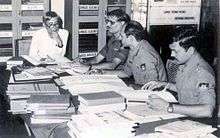
The Government acknowledged this achievement by announcing awards for the whole crew on Republic Day, 1987.[32]
Maj AK Singh became the first disabled sailor to circumnavigate the globe in a sail boat and this was recorded in the Limca Book of Records[33]
References
- 1 2 Dom Moraes (1987). Trishna. Bombay, India: Perennial Press. Retrieved 20 June 2013.
- 1 2 Gupta, Shubhra (18 January 1987). "Saga of the doughty Trishna". Sunday Mail. Bombay, India.
- 1 2 Mohapatra, Satyen (29 September 1985). "Around-the-World Cruise Begins". Times of India. Bombay, India. The Times Group. Retrieved 30 September 2013.
- ↑ "Yachting expedition flagged off". The Times of India. Bombay. 29 September 1985.
|first1=missing|last1=in Authors list (help) - ↑ "'Trishna' set for last leg of expedition". Indian Express. New Delhi, India. 31 October 1985.
- ↑ "Indian Express 31 Oct 1985". Archive.org. 1985-10-31. Retrieved 2013-10-01.
- ↑ Chowdhury, TPS (15 January 1986). "Around the World in a Yacht". Sainik Samachar. New Delhi, India. p. 34.
- ↑ "Free Press Journal 04 Dec 1985". Archive.org. 1985-12-04. Retrieved 2013-10-01.
- ↑ "'Trishna' reaches Ascension Island". National Herald. New Delhi, India. 23 December 1985.
- ↑ "National Herald New Delhi 23 Dec 1985". Archive.org. 1985-12-23. Retrieved 2013-10-01.
- ↑ Pal, Samir (15 February 1996). "Trishna yacht is close to midway". The Hindustan Times. India. p. 24.
- ↑ "'Trishna' heading for Natal". Free Press Journal. Bombay, India. 20 December 1985.
- ↑ "Free Press Journali 20 Dec 1985". Archive.org. 1985-12-20. Retrieved 2013-10-01.
- ↑ Moraes, Dom (March 1987). "The Travellers on Trishna". Imprint. Bombay, India. p. 6.
- ↑ "Imprint Mar 1987". Archive.org. Retrieved 2013-10-01.
- ↑ "'Round the world' Indians make Bajan port-of-call". Sunday Sun. Barbados. 9 February 1986. p. 2.
- ↑ "Spillway Del Canal De Panama 11 Apr 1986". Archive.org. 1986-04-11. Retrieved 2013-10-01.
- ↑ ""Trishna" enters Pacific". Tribune. Chandigarh, India. 2 March 1986.
- ↑ "Tribune Chandigarh 02 Mar 1986". Archive.org. 1986-03-02. Retrieved 2013-10-01.
- ↑ "Indian expedition departs for Tahiti". Jansatta. New Delhi, India. 9 April 1986.
- ↑ "Jansatta New Delhi 09 Apr 1986". Archive.org. 1986-04-09. Retrieved 2013-10-01.
- ↑ Rau, R Madhav (28 December 1986). "Near the end". Newstime Weekend. Hyderabad, India.
- ↑ "BoM NSW - East Coast Lows". Bom.gov.au. Retrieved 2013-10-01.
- ↑ "Trishna returns to rousing welcome". Daily. Bombay, India. 11 December 1986.
- ↑ "Daily Bombay 11 Dec 1986". Archive.org. 1986-12-11. Retrieved 2013-10-01.
- ↑ "Trishna home to hero's welcome". Indian Express. Bombay, India. 11 January 1987.
- ↑ "Indian Express Bombayl 11 Jan 1987". Archive.org. 1987-01-11. Retrieved 2013-10-01.
- ↑ "Indian Express Bombayl 11 Jan 1987". Archive.org. 1987-01-11. Retrieved 2013-10-01.
- ↑ "Yacht Trishna And Route Map". Indianpost.com. Retrieved 2013-10-01.
- ↑ "Xi The Writing On The Wall". Oceancruisingclub.org. Retrieved 2013-10-01.
- ↑ "Dom Moraes' Trishna is launched". The Indian Post. Bombay, India. 10 March 1988.
- ↑ UNI (26 January 1987). "Trishna sailors honoured". The Times of India. Bombay. p. 3.
- ↑ Ashwini Manjul; Garima Tripathi; Taurus Infotek. "Welcome to". Prideofindia.net. Retrieved 2013-10-01.